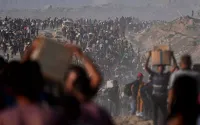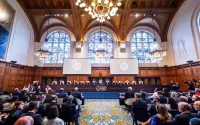With the past few days' avalanche of spin, you could be forgiven for thinking that on January 30 2005 the US-led occupation of Iraq ended and the people won their freedom and democratic rights. This has been a multi-layered campaign, reminiscent of the pre-war WMD frenzy and fantasies about the flowers Iraqis were collecting to throw at the invasion forces. How you could square the words democracy, free and fair with the brutal reality of occupation, martial law, a US-appointed election commission and secret candidates has rarely been allowed to get in the way of the hype.
If truth is the first casualty of war, reliable numbers must be the first casualty of an occupation-controlled election. The second layer of spin has been designed to convince us that an overwhelming majority of Iraqis participated. The initial claim of 72% having voted was quickly downgraded to 57% of those registered to vote. So what percentage of the adult population is registered to vote? The Iraqi ambassador in London was unable to enlighten me. In fact, as UN sources confirm, there has been no registration or published list of electors - all we are told is that about 14 million people were entitled to vote.
The Iraqi south, more religious than Baghdad, responded positively to Grand Ayatollah al-Sistani's position: to call the bluff of the US and vote for a list that was proclaimed to be hostile to the occupation. Sistani's supporters declared that voting on Sunday was the first step to kicking out the occupiers. The months ahead will put these declarations to a severe test. Meanwhile Moqtada al-Sadr's popular movement, which rejected the elections as a sham, is likely to make a comeback in its open resistance to the occupation.
The big vote in Kurdistan primarily reflects the Kurdish people's demand for national self-determination. The US administration has hitherto clamped down on these pressures. Henry Kissinger's recent proposal to divide Iraq into three states reflects a major shift among influential figures in the US who, led by Kissinger as secretary of state, ditched the Kurds in the 70s and brokered a deal between Saddam and the Shah of Iran.
George Bush and Tony Blair made heroic speeches on Sunday implying that Iraqis had voted to approve the occupation. Those who insist that the US is desperate for an exit strategy are misreading its intentions. The facts on the ground, including the construction of massive military bases in Iraq, indicate that the US is digging in to install and back a long-term puppet regime. For this reason, the US-led presence will continue, with all that entails in terms of bloodshed and destruction.
In the run-up to the poll, much of the western media presented it as a high-noon shootout between the terrorist Zarqawi and the Iraqi people, with the occupation forces doing their best to enable the people to defeat the fiendish, one-legged Jordanian murderer. In reality, Zarqawi-style sectarian violence is not only condemned by Iraqis across the political spectrum, including supporters of the resistance, but is widely seen as having had a blind eye turned to it by the occupation authorities. Such attitudes are dismissed by outsiders, but the record of John Negroponte, the US ambassador in Baghdad, of backing terror gangs in central America in the 80s has fuelled these fears, as has Seymour Hirsh's reports on the Pentagon's assassination squads and enthusiasm for the "Salvador option".
An honest analysis of the social and political map of Iraq reveals that Iraqis are increasingly united in their determination to end the occupation. Whether they participated in or boycotted Sunday's exercise, this political bond will soon reassert itself - just as it did in Vietnam - despite tactical differences, and despite the US-led occupation's attempts to dominate Iraqis by inflaming sectarian and ethnic divisions.
· Sami Ramadani was a political refugee from Saddam Hussein's regime and is a senior lecturer at London Metropolitan University






